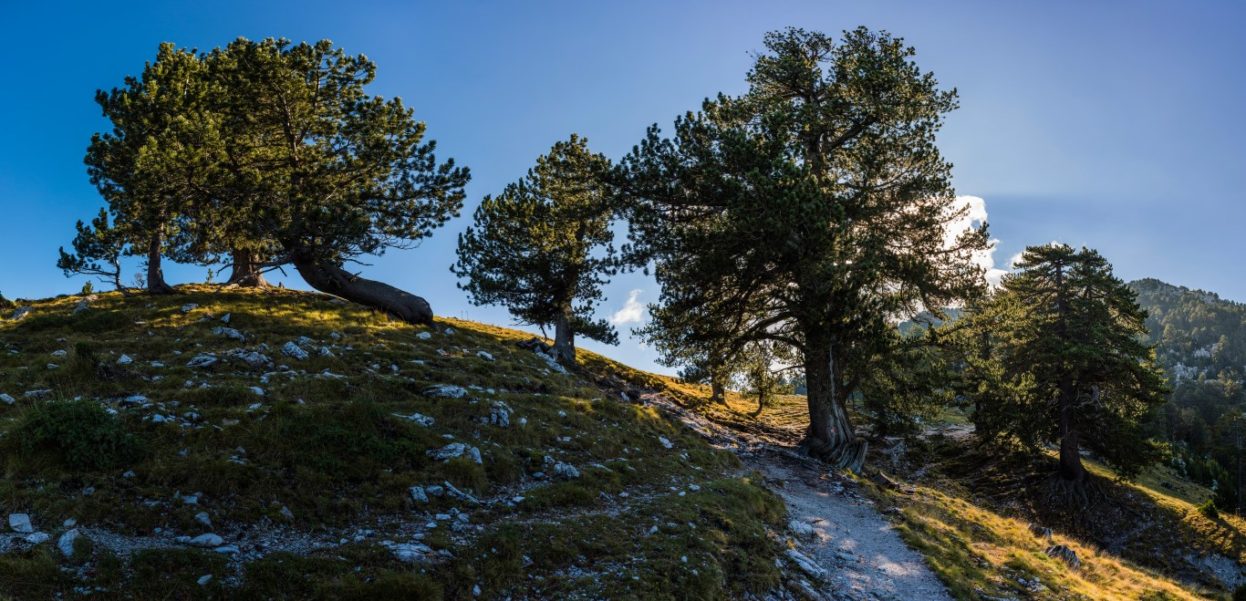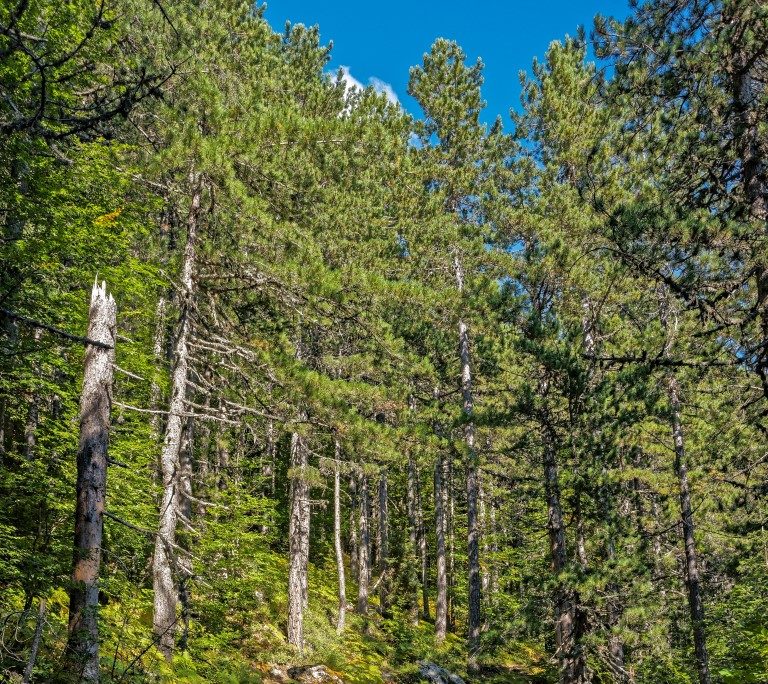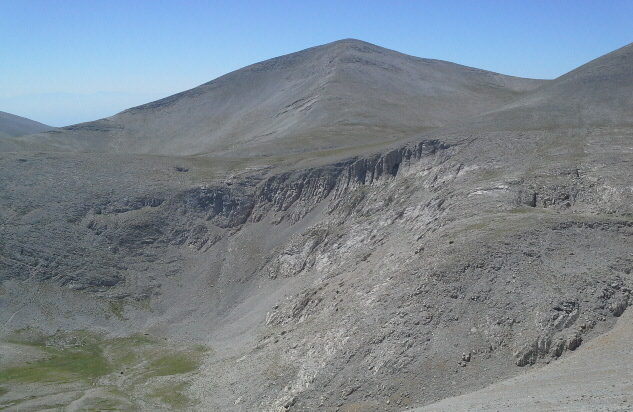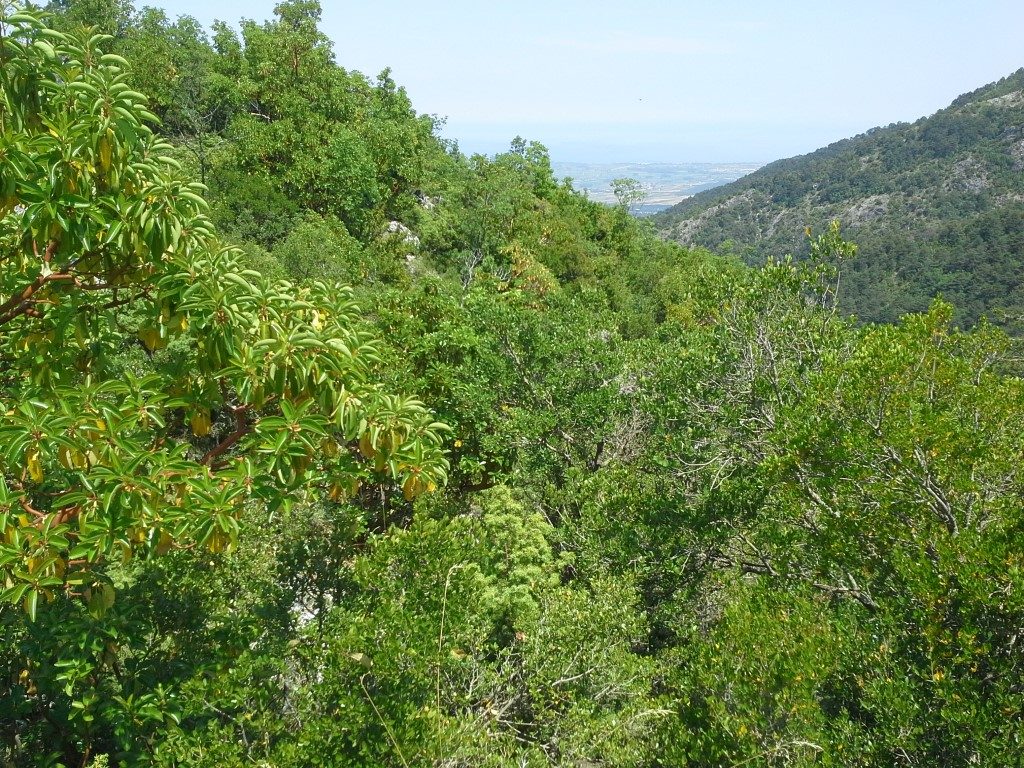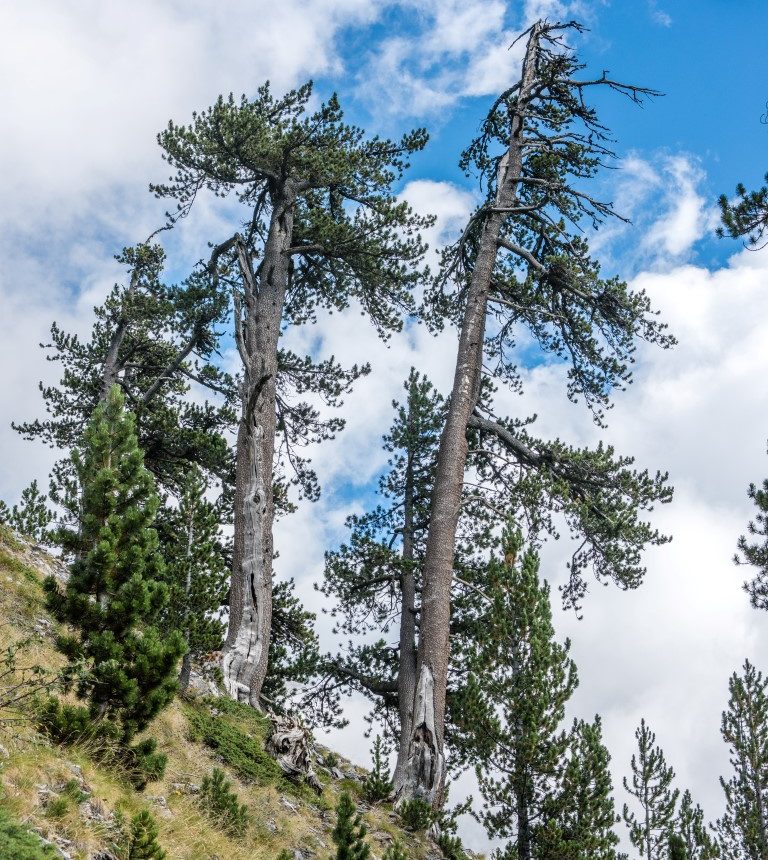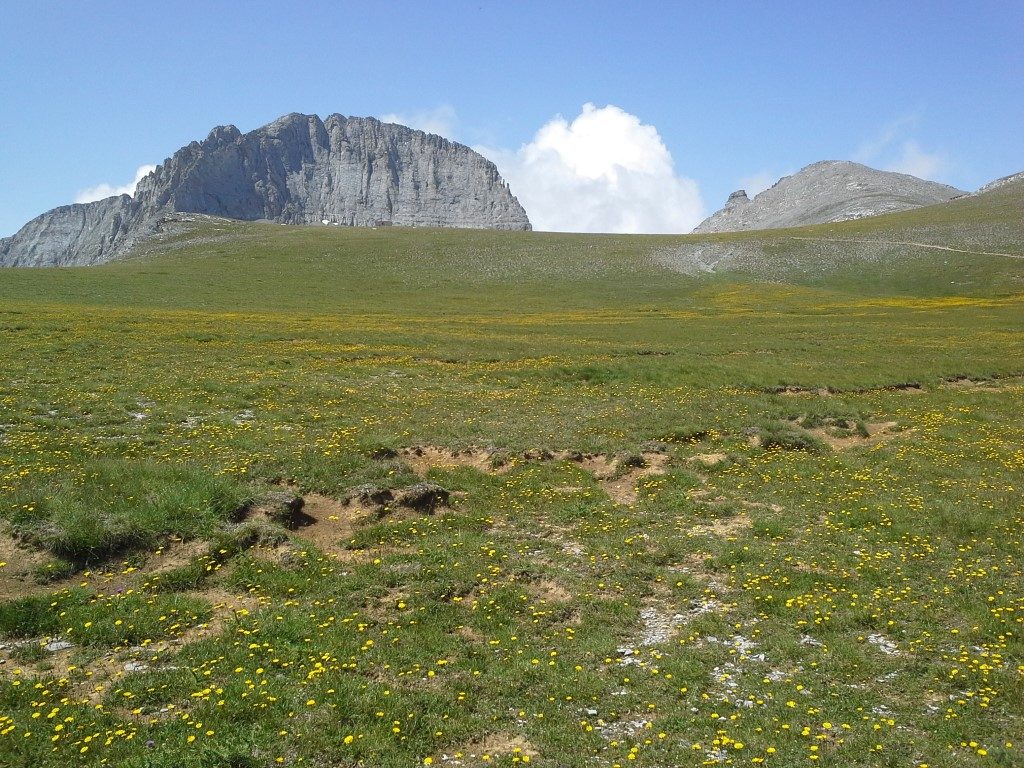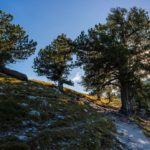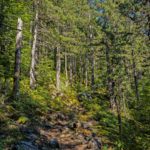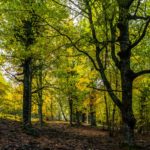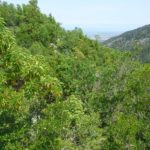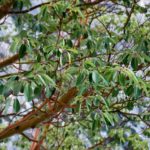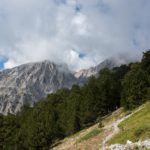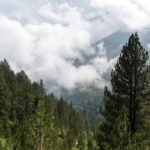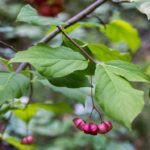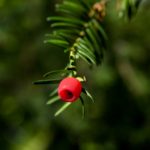Vegetation Ζones
Olympus is characterized by a wide variety of vegetation types formed by its intense topographic relief, short distance from the sea and the existence of many micro-environments1. In general, four vegetation zones can be distinguished on Mount Olympus. However, due to the intense variations in short-term environmental conditions, these zones are often not entirely distinct because species that define a particular vegetation zone may enter into other vegetation zones.
Zone of broad-leaved evergreens
The first zone of broad-leaved evergreens (Quercetalia ilicis) is found at an altitude of 300 to 500 meters. The area is dominated by shrubs and low-rising trees such as the holm oak (Quercus ilex), Greek strawberry tree (Arbutus adrachnae), kermes oak (Quercus coccifera), strawberry tree (Arbutus unedo), prickly Juniper (Juniperus oxycedrus), etc. Characteristic deciduous species at this altitude include manna ash (Fraxinus ornus), Montpellier maple (Acer monspessulanum), Judas-tree (Cercis siliquastrum), European smoke tree (Cotinus coggygria) and others.
Forest of beech-fir and mountain conifers
Forest of beech-fir and mountain conifers (Fagetalia) stretch from 600 to 1400 meters, wherein black pines (Pinus nigra) dominate in pure stands. In smaller clusters and stands, one can encounter Bulgarian fir (Abies borissi-regis), European beech (Fagus sylvatica), wych elm (Ulmus glabra), yew (Taxus baccata), hazel (Coryllus avellana), Cornelian cherry (Cornus mas), cherry plum (Prunus cerasifera) and a variety of herbaceous plants.
Zone of cold-hardy conifers
At elevations between 1400 and 2500 m, the zone of cold-hardy conifers (Vaccinio-Picetalia) emerges. The predominant species of pine is the rare Bosnian pine (Pinus heldreichii), which makes its first appearance at 1100 m, gradually replacing black pine (Pinus nigra) and forming unmixed forests up to 2000 meters. Areas with Bosnian pine are usually dry with rocky slopes. The vegetation that grows in this region is adapted to specific local conditions and is represented by characteristic shrubs, grasses, chasmophytes, while the flora includes many endemic species of the Balkans.
The non-forested high mountain meadows and grasslands
Above 2500 meters, which is also the highest treeline in the Balkans, there are the non-forested high mountain meadows and grasslands (Astragalo-Acantholimonetalia). On Mount Olympus, these meadows display a great diversity and their floral composition includes many rare wildflowers, most of which are endemic to Greece and the Balkan Peninsula.
Azonal forests
In addition to the above vegetation zones, azonal forests can be found along the canyons and gorges of Mount Olympus. In the presence of continuous water flow, oriental plane trees (Platanus orientalis) and willows (Salix alba, Salix cinerea) dominate. Similarly, temperate deciduous broad-leaved forests (Quercetalia pubescentis) are fragmented and scattered at altitudes of 400 to 600 meters. Different species of oak such as Hungarian oak (Quercus frainetto), sessile oak (Q. petraea), and downy oak (Q. pubescens) can be found at these localities2.
Gallery
NATURA 2000 Habitat Types
Olympus is included in the European NATURA 2000 Network as a Special Area of Conservation (SAC) and a Special Protection Area for Birds (SPA) under the code name "Mount Olympus-GR1250001”.
Following the results of the programme "Surveillance and evaluation of the conservation status of habitat types of European community interest in the area of jurisdiction of Olympus National Park Management Agency"2, 19 habitat types were recorded under the European Directive 92/43/EEC "On the conservation of natural habitats and of wild fauna and flora". Among them are included four priority habitatsa (9530, 6230, 9180, 9580), whereas those of the alpine zone, namely the meadows and rocky formations (6170, 6230, 8140, 8210), are of particular importance since the majority of endemic species of Olympus are found here.
It is also worth mentioning that priority habitat 9530 * - (Sub-)Mediterranean pine forests with endemic black pines occupies almost 40% of the NATURA 2000 site, while habitat type “95A0- High oro-Mediterranean pine forests” is of equal importance with Pinus leucodermis forming the highest forest limits in the Balkans.
| Α/Α | CODE | NAME |
|---|---|---|
| 1 | 3240 | Alpine rivers and their ligneous vegetation with Salix elaeagnos |
| 2 | 4060 | Alpine and boreal heaths |
| 3 | 4090 | Endemic oro-Mediterranean heaths with gorse |
| 4 | 5310 | Laurus nobilis thickets |
| 5 | 6170 | Alpine and subalpine calcareous grasslands |
| 6 | 6230* | Species-rich Nardus grasslands, on siliceous substrates in mountain areas (and sub-mountain areas, in Continental Europe) |
| 7 | 8140 | Eastern Mediterranean screes |
| 8 | 8210 | Calcareous rocky slopes with chasmophytic vegetation |
| 9 | 9130 | Asperulo-Fagetum beech forests |
| 10 | 9140 | Medio-European subalpine beech woods with Acer and Rumex arifolius |
| 11 | 9150 | Medio-European limestone beech forests of the Cephalanthero-Fagion |
| 12 | 9180* | Tilio-Acerion forests of slopes, screes and ravines |
| 13 | 91Μ0 | Pannonian-Balkanic turkey oak — sessile oak forests |
| 14 | 9270 | Hellenic beech forests with Abies borisii-regis |
| 15 | 92C0 | Platanus orientalis and Liquidambar orientalis woods (Plantanion orientalis) |
| 16 | 9340 | Quercus ilex and Quercus rotundifolia forests |
| 17 | 9530* | (Sub-)Mediterranean pine forests with endemic black pines |
| 18 | 95A0 | High oro-Mediterranean pine forests |
| 19 | 9580* | Mediterranean Taxus baccata woods |
Priority habitat types of EU Directive 92/43/ΕEC are denoted with an asterisk*.
a Priority habitats / Species: Natural habitats and species that are in danger of disappearance for the conservation of which the Community has particular responsibility in view of the proportion of their natural range which falls within its territory. They are denoted by an asterisk (*) in Annexes I and II and special measures apply to them.
b Annex I Habitat types of EU Habitat’s Directive 92/43/EEC: Natural habitat types of community interest whose conservation requires the designation of special areas of conservation.
c Annex II Species of EU Habitat’s Directive 92/43/EEC: Animal and plant species of community interest whose conservation requires the designation of special areas of conservation.
d Annex IV Species of EU Habitat’s Directive 92/43/EEC: Animal and plant species of community interest in need of strict protection.
e Annex Ι species of EU Wild Bird’s Directive 2009/147/ΕEC: Species that are subject to special conservation measures concerning their habitat in order to ensure their survival and reproduction in their area of distribution.
1 «Specialized Environmental Study of Olympus National Park» (2010). Ministry of Environment, Energy and Climate Change, Dept. of Environmental Planning, Division for the Management of the Natural Environment.
2 Tsitsoni Th., Fotiadis G., ELKE-AUTH (2015). «Surveillance and evaluation of the conservation status of Habitat Types of European Community Interest in the area of jurisdiction of Olympus National Park Management Agency». Phase D’. ONPMA, RDP Macedonia-Thrace 2007-2013.
3 Council Directive 92/43/EEC “On the Conservation of Natural Habitats and of Wild Fauna and Flora”.
4 Strid, A. (1980). Wild Flowers of Mount Olympus. Goulandri Natural History Museum, Athens.
5 Tsitsoni Th., Fotiadis G., Tsitinis G., ELKE-AUTH (2015). «Surveillance and evaluation of the conservation status of Plant species of European Community Interest in the area of jurisdiction of Olympus National Park Management Agency». Phase D’. ONPMA, RDP Macedonia-Thrace 2007-2013.
6 Sokos, Ch., Birtsas P., Hatzinikos E., Bontzorlos V., Papaspyropoulos, Κ., et al., TECHNOOMOIOSTASI-YLORIKI-LOUVITAKIS (2015). «Surveillance and evaluation of the conservation status of Mammals of European Community Interest in the area of jurisdiction of Olympus National Park Management Agency». Phase D’. ONPMA, RDP Macedonia-Thrace 2007-2013.
7 Olympus National Park Management Agency (2017). Technical Report 2016 on the Monitoring of Environmental Parameters, Litochoro.
8 Olympus National Park Management Agency (2016). Technical Report 2015 on the Monitoring of Environmental Parameters, Litochoro.
9 Legakis, A. & Maragou, P. (2009). The Red Book of Endangered Animals of Greece. Hellenic Zoological Society, Athens.
10 Bousbouras, D. & YETOS Ο.Ε. (2015). «Surveillance and evaluation of the conservation status of Birds of European Community Interest in the area of jurisdiction of Olympus National Park Management Agency». Phase D’. ONPMA, RDP Macedonia-Thrace 2007-2013.
11 Directive 2009/147/EC of the European Parliament and the Council of 30 November 2009 “On the Conservation of Wild Birds”.
12 Ioannidis I., Papamichail G., GEOANALYSIS Α.Ε. (2015) «Surveillance and evaluation of the conservation status of Amphibians & Reptiles of European Community Interest in the area of jurisdiction of Olympus National Park Management Agency». Phase D’. ONPMA, RDP Macedonia-Thrace 2007-2013.
13 Pamperis, L. (2009). The Butterflies of Greece. 2nd edition, PAMPERI & ΚΟΑΝ publishers, Athens. Website www.pamperis.gr for updates on the book.
14 Avtzis D., Kaltsas D., TECHNOOMOIOSTASI-YLORIKI-LOUVITAKIS (2015) «Surveillance and evaluation of the conservation status of Invertebrates of European Community Interest in the area of jurisdiction of Olympus National Park Management Agency». Phase D’. ONPMA, RDP Macedonia-Thrace 2007-2013.
15 Presidential Decree 67/1981 (Hellenic Government Gazette No. 23 Α’/30-1-1981) “On the protection of native flora and wild fauna and the procedures for the coordination and control of their research”.
16 Heath, J. (1981) Threatened Rhopalocera (butterflies) of Europe. Council of Europe.
17 Tolmann, T. & Lewington, R. (2008). Collins Butterfly Guide: The Most Complete Field Guide to the Butterflies of Britain and Europe. 3rd Edition, HarperCollins UK.
18 Speight M.C.D. (1989). Saproxylic invertebrates and their conservation. Council of Europe.

